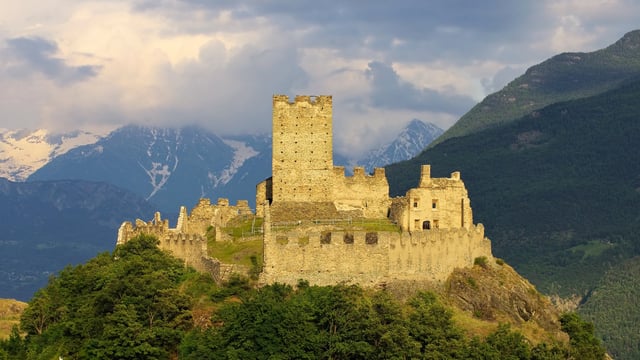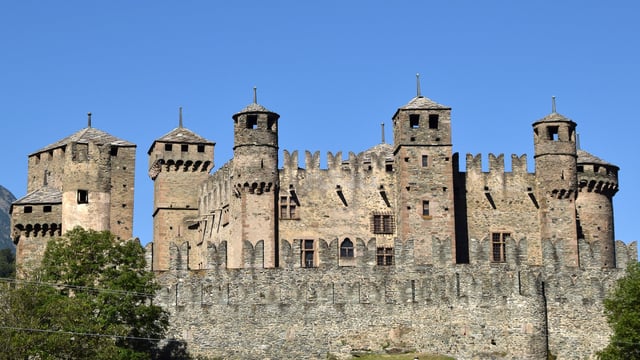Aosta Valley
Art, History & Archaeology Sites & Museums
This page, part of our Italy Travel Guide, provides details of the art, archaeology and history sites, museums and related attractions to visit in the Italian province of Aosta Valley. Readers wishing to visit these places will find visitor information, links to official websites as well as other helpful resources. Those who have an account (free of charge) can create their own travel lists and itineraries. To benefit fully from this website’s travel planning features, see the User’s Guide. The information on this page has been put together by various members of the Archaeology Travel team, based on both personal visits and research. The page was last checked and/or updated on 27 October 2023.
Create Your Aosta Valley Itinerary & Travel Lists
If you are planning a trip to Aosta Valley, and other regions in Italy, you can use our Itinerary Builder with the list of sites and museums below to create your own travel lists (such as places you have been to, places you would like to visit) and itineraries. These can be shared with your friends, privately and on social media. To make use of this feature, however, you will need to login or register as a new user. Registering to use these features is free of charge. Once registered and logged in, you can use the lists below to select sites and museums you would like to add to your itinerary and/or travel lists. Please Note: the lists below only include sites and museums in the Italian province of Aosta Valley, go to the Italy Travel Guide to find places to visit in the other provinces.
Archaeology & History Sites in Aosta Valley
Aosta
The city of Aosta lies on a plain in the centre of the Aosta Valley, connected to France and Switzerland by two passes through the Alps. Also known as the Rome of the Alps, it was founded by the Romans during the war with the Salassi people. It became a transit point for the Via Francigena during the Middle Ages. Its long cold winters, short warm summers, and proximity to famous ski areas make it a perfect destination for mountain and snow lovers.

Pont D’Aël
Today the Roman bridge is part of a popular hiking trail in a side valley of the Aosta Valley. In 3 BC this bridge was part of a six kilometre aqueduct that carried water to present-day Aosta for agricultural purposes in the then colony of Augusta Prætoria Salassorum. The top of the bridge is 66 metres above the valley floor, and when built there would have been a roofed control corridor. A Latin inscription on the bridge records that it was constructed by Caius Avillius Caimus from Padova using private funds.

Pont Saint-Martin
When the Romans defeated the Salassi tribe, it was the strategic mountain passes that they sought to control. In securing the mountainous routes they built a number of roads and bridges. The remains of some of these ancient roads are still visible in many places along the valley, and even the modern railway line follows these ancient routes. The single segmental arch bridge over the Lys River in Saint-Martin is one such Roman bridge. The bridge has a span of 35 metres, and a width of 4.5 metres.

Roman Aosta - Augusta Prætoria Salassorum
Once the centre of the Salassi Celtic tribe, Augusta Prætoria Salassorum was prized for its strategic position and became an important military post. In fact Aosta’s layout still resembles that of a Roman military camp. Many architectural features from the town’s Roman times have survived and some are quite well preserved. The city walls, for example, are all but complete, and six of the original 20 towers are still standing. The remains of the theatre, amphitheatre and forum can be visited, while a triumphal arch to Augustus still has pride of place.

Roman Consular Road - Donnas
Just west of the town of Donnas, on the north side of the SS26 is a 221 m section of the Roman consular road, with its arch and milestone. Known as the Via delle Gallie, Gauls Road, it was built to link Rome to the Aosta Valley. The milestone has the number 36, being the number of miles between Donnas and Aosta. The road and arch was cut into the bedrock. And on the road’s surface you can still see cart wheel ruts. A nearby carpark gives access to a footpath running between the Roman road and the motorway.

Forts & Castles in the Aosta Valley
Cly Castle
Cly Castle is a typical example of a Valdostan medieval fortress. Namely a central square tower surrounded by a defensive wall, and placed in a strategic location to exploit the natural defensive elements of the setting. Tree-ring analyses indicate that the castle was built in 1027 AD, making this one of the oldest castles of its type in the Aosta Valley. Of particular note is the Romanesque chapel within the fortification. Inside the chapel are frescoes from three distinct periods in the 13th and 14th centuries. Sadly, these are not well preserved, due to preservation and vandalism.

Fénis Castle
This Medieval castle is one of the most visited tourist attractions in the Aosta Valley. The castle has a typical defensive layout, which includes a pentagonal keep with towers at each corner. The keep is surrounded by a double wall complete with battlements, watchtowers and walkways. Built on top of a small hill and contrary to first impressions, the castle did not have a military or defensive purpose. Rather, it was a prestigious family residence. What visitors see today dates to the early 15th century.










